Spark(四十七):Spark UI 数据可视化
导入:
1)Spark Web UI主要依赖于流行的Servlet容器Jetty实现;
2)Spark Web UI(Spark2.3之前)是展示运行状况、资源状态和监控指标的前端,而这些数据都是由度量系统(MetricsSystem)收集来的;
3)Spark Web UI(spark2.3之后)呈现的数据应该与事件总线和ElementTrackingStore关系紧密,而MetricsSystem是一个向外部提供测量指标的存在
具体Spark UI存储更改可以通过spark issue查看:
Key-value store abstraction and implementation for storing application data
Use key-value store to keep History Server application listing
Hook up Spark UI to the new key-value store backend
Implement listener for saving application status data in key-value store
Make Environment page use new app state store
Make Executors page use new app state store
Spark UI界面可以包含选项卡:Jobs,Stages,Storage,Enviroment,Executors,SQL
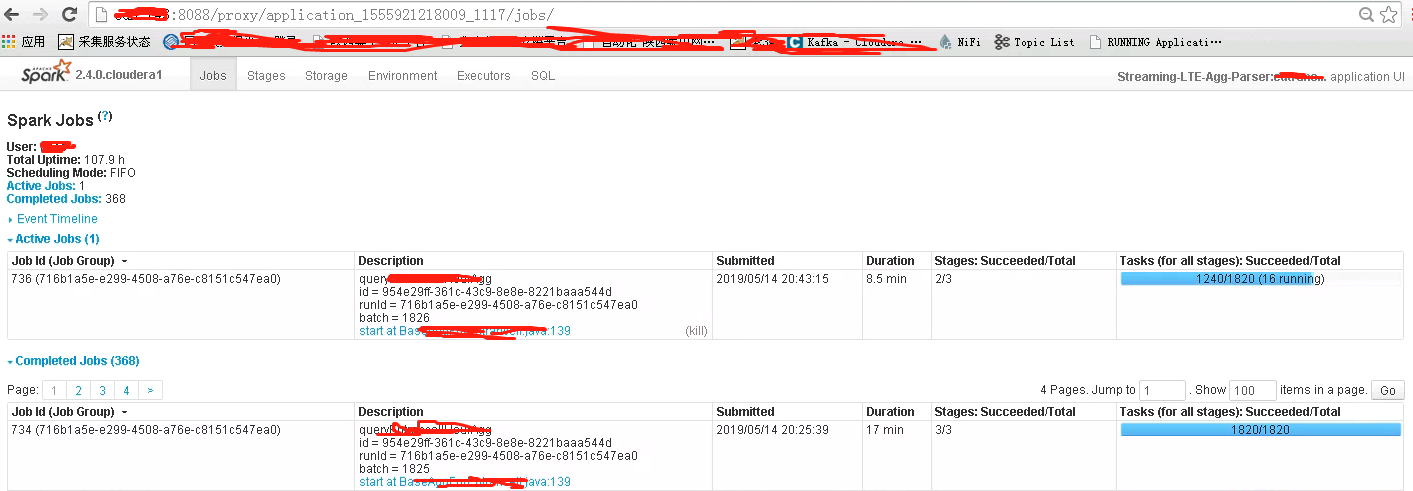
Spark UI(http server)是如何被启动?
接下来让我们从源码入手查看下Spark UI(http server)是如何被启动的,页面中的数据从哪里获取到。
Spark UI中用到的http server是jetty,jetty采用java编写,是比较不错的servlet engine和http server,能嵌入到用户程序中执行,不用用tomcat或jboss那样需要运行在独立jvm进程中。
1)SparkContext初始化时启动SparkUI
Spark UI(http server)在SparkContext初始化的时候被创建:
...
private var _listenerBus: LiveListenerBus = _
private var _statusStore: AppStatusStore = _
... private[spark] def ui: Option[SparkUI] = _ui _listenerBus = new LiveListenerBus(_conf) // Initialize the app status store and listener before SparkEnv is created so that it gets // all events. _statusStore = AppStatusStore.createLiveStore(conf) listenerBus.addToStatusQueue(_statusStore.listener.get)
。。。。
_ui = if (conf.getBoolean("spark.ui.enabled", true)) { Some(SparkUI.create(Some(this), _statusStore, _conf, _env.securityManager, appName, "", startTime)) } else { // For tests, do not enable the UI None } // Bind the UI before starting the task scheduler to communicate // the bound port to the cluster manager properly _ui.foreach(_.bind()) 。。。 _ui.foreach(_.setAppId(_applicationId))
...
其中,_statusStore是AppStatusStore初始化对象,它内部包装了KVStore和AppStatusListener:
- KVStore用于存储监控数据,
- AppStatusListener注册到事件总线中的appStatus队列中。
_env.securityManager则是SparkEnv中初始化的安全管理器。
SparkContext通过调用SparkUI伴生对象中的create()方法来直接new出SparkUI实例,然后调用bind()方法将SparkUI绑定到Jetty服务。
2)SparkUI类对象初始化
SparkUI调用create方法后会初始化一个SparkUI对象,在SparkUI对象被初始化时,会调用SparkUI的initialize()方法
private[spark] class SparkUI private ( val store: AppStatusStore, val sc: Option[SparkContext], val conf: SparkConf, securityManager: SecurityManager, var appName: String, val basePath: String, val startTime: Long, val appSparkVersion: String) extends WebUI(securityManager, securityManager.getSSLOptions("ui"), SparkUI.getUIPort(conf), conf, basePath, "SparkUI") with Logging with UIRoot { val killEnabled = sc.map(_.conf.getBoolean("spark.ui.killEnabled", true)).getOrElse(false) var appId: String = _ private var streamingJobProgressListener: Option[SparkListener] = None /** Initialize all components of the server. */ def initialize(): Unit = { val jobsTab = new JobsTab(this, store) attachTab(jobsTab) val stagesTab = new StagesTab(this, store) attachTab(stagesTab) attachTab(new StorageTab(this, store)) attachTab(new EnvironmentTab(this, store)) attachTab(new ExecutorsTab(this)) addStaticHandler(SparkUI.STATIC_RESOURCE_DIR) attachHandler(createRedirectHandler("/", "/jobs/", basePath = basePath)) attachHandler(ApiRootResource.getServletHandler(this)) // These should be POST only, but, the YARN AM proxy won't proxy POSTs attachHandler(createRedirectHandler( "/jobs/job/kill", "/jobs/", jobsTab.handleKillRequest, httpMethods = Set("GET", "POST"))) attachHandler(createRedirectHandler( "/stages/stage/kill", "/stages/", stagesTab.handleKillRequest, httpMethods = Set("GET", "POST"))) }
SparkUI类中有3个属性成员:
- killEnabled由配置项spark.ui.killEnable控制。如果为true,则会在Spark Web UI界面中展示强行杀掉Spark Application Job的开关;
- appId就是当前的Application ID;
- streamingJobProgressListener是用于Spark Streaming作业进度的监听器。
在initialize()方法中,
- 首先,会创建JobsTab、StagesTab、StorageTab、EnvironmentTab、ExecutorsTab这5个Tab,并调用了attachTab()方法注册到Web UI。这里的Tab是Spark UI中的标签页,参考上图,名称也是一一对应。
- 然后,调用addStaticHandler()方法创建静态资源的ServletContextHandler,又调用createRedirectHandler()创建一些重定向的ServletContextHandler。
- 最后,逐一调用attachHandler()方法注册到Web UI。
备注:ServletContextHandler是Jetty中一个功能完善的处理器,负责接收并处理HTTP请求,再投递给Servlet。
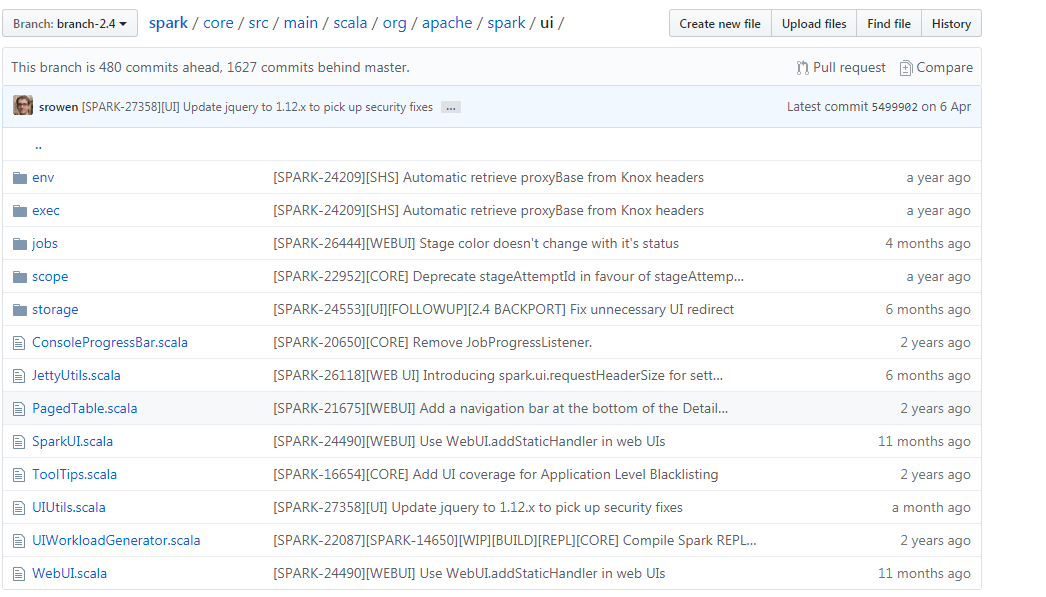
上边每个JobsTab、StagesTab、StorageTab、EnvironmentTab、ExecutorsTab除了包含有渲染页面类,还包含资源html&js&css&其他(图片)(https://github.com/apache/spark/tree/branch-2.4/core/src/main/resources/org/apache/spark/ui/static)
3)执行bind()方法启动jetty服务
在上边SparkContext初始化时,创建了SparkUI对象,将会调用bind()方法将SparkUI绑定到Jetty服务,这个bind()方法SparkUI子类WebUI中的一个方法。
WebUI属性成员和Getter方法
protected val tabs = ArrayBuffer[WebUITab]() protected val handlers = ArrayBuffer[ServletContextHandler]() protected val pageToHandlers = new HashMap[WebUIPage, ArrayBuffer[ServletContextHandler]] protected var serverInfo: Option[ServerInfo] = None protected val publicHostName = Option(conf.getenv("SPARK_PUBLIC_DNS")).getOrElse( conf.get(DRIVER_HOST_ADDRESS)) private val className = Utils.getFormattedClassName(this) def getBasePath: String = basePath def getTabs: Seq[WebUITab] = tabs def getHandlers: Seq[ServletContextHandler] = handlers def getSecurityManager: SecurityManager = securityManager
https://github.com/apache/spark/blob/branch-2.4/core/src/main/scala/org/apache/spark/ui/WebUI.scala
WebUI属性成员有6个:
- tabls:持有WebUITab(Web UI中的tab页)的缓存;
- handlers:持有Jetty ServletContextHandler的缓存;
- pageToHandlers:保存WebUIPage(WebUITab的下一级组件)与其对应的ServletContextHandler的映射关系;
- serverInfo:当前Web UI对应的Jetty服务器信息;
- publicHostName:当前Web UI对应的Jetty服务主机名。先通过系统环境变量SPARK_PUBLIC_DNS获取,在通过spark.driver.host配置项获取。
- className:当前类的名称,用Utils.getFormattedClassName()方法格式化过。
Getter方法有4个:
- getTabs()和getHandlers()都是简单地获得对应属性的值;
- getBasePath()获得构造参数中定义的Web UI基本路劲;
- getSecurityManager()则取得构造参数中传入的安全管理器。
WebUI提供的attache/detach类方法
这些方法都是成对出现,一共有3对:
- attachTab/detachTab:用于注册和移除WebUIPage;
- attachPage/detachPage:用于注册和移除WebUIPage;
- attachHandler/detaHandler:用于注册和移除ServletContextPage。
/** Attaches a tab to this UI, along with all of its attached pages. */ def attachTab(tab: WebUITab): Unit = { tab.pages.foreach(attachPage) tabs += tab } /** Detaches a tab from this UI, along with all of its attached pages. */ def detachTab(tab: WebUITab): Unit = { tab.pages.foreach(detachPage) tabs -= tab }
/** Detaches a page from this UI, along with all of its attached handlers. */ def detachPage(page: WebUIPage): Unit = { pageToHandlers.remove(page).foreach(_.foreach(detachHandler)) } /** Attaches a page to this UI. */ def attachPage(page: WebUIPage): Unit = { val pagePath = "/" + page.prefix val renderHandler = createServletHandler(pagePath, (request: HttpServletRequest) => page.render(request), securityManager, conf, basePath) val renderJsonHandler = createServletHandler(pagePath.stripSuffix("/") + "/json", (request: HttpServletRequest) => page.renderJson(request), securityManager, conf, basePath) attachHandler(renderHandler) attachHandler(renderJsonHandler) val handlers = pageToHandlers.getOrElseUpdate(page, ArrayBuffer[ServletContextHandler]()) handlers += renderHandler }
/** Attaches a handler to this UI. */ def attachHandler(handler: ServletContextHandler): Unit = { handlers += handler serverInfo.foreach(_.addHandler(handler)) } /** Detaches a handler from this UI. */ def detachHandler(handler: ServletContextHandler): Unit = { handlers -= handler serverInfo.foreach(_.removeHandler(handler)) } def detachHandler(path: String): Unit = { handlers.find(_.getContextPath() == path).foreach(detachHandler) }
def addStaticHandler(resourceBase: String, path: String = "/static"): Unit = { attachHandler(JettyUtils.createStaticHandler(resourceBase, path)) }
https://github.com/apache/spark/blob/branch-2.4/core/src/main/scala/org/apache/spark/ui/WebUI.scala
attachPage()方法流程:
- 1)调用Jetty工具类JettyUtils的createServletHandler()方法,为WebUIPage的两个渲染方法render()和readerJson()创建ServletContextHandler,也就是一个WebUIPage需要对应两个处理器。
- 2)然后,调用上述attachHandler()方法向Jetty注册处理器,并将映射关系写入handlers结构中。
WebUI绑定到Jetty服务
/** Binds to the HTTP server behind this web interface. */ def bind(): Unit = { assert(serverInfo.isEmpty, s"Attempted to bind $className more than once!") try { val host = Option(conf.getenv("SPARK_LOCAL_IP")).getOrElse("0.0.0.0") serverInfo = Some(startJettyServer(host, port, sslOptions, handlers, conf, name)) logInfo(s"Bound $className to $host, and started at $webUrl") } catch { case e: Exception => logError(s"Failed to bind $className", e) System.exit(1) } }
https://github.com/apache/spark/blob/branch-2.4/core/src/main/scala/org/apache/spark/ui/WebUI.scala
这个bind()方法,包含节点信息:
a)其中调用startJettyServer(...)方法,该方法是JettyUtils.scala中的一个方法,这点也说明了SparkUI运行时基于jetty实现的。
b)调用startjettyServer(...)方法传递了host,port参数,这两个参数也是Spark UI访问的ip和端口,我们需要了解下这两个参数具体的配置在哪里。
√ host的获取代码:
val host = Option(conf.getenv("SPARK_LOCAL_IP")).getOrElse("0.0.0.0")
spark-env.sh包含了参数(SPARK_LOCAL_IP、SPARK_PUBLIC_DNS):
# Options read when launching programs locally with # ./bin/run-example or ./bin/spark-submit # - HADOOP_CONF_DIR, to point Spark towards Hadoop configuration files # - SPARK_LOCAL_IP, to set the IP address Spark binds to on this node # - SPARK_PUBLIC_DNS, to set the public dns name of the driver program # Options read by executors and drivers running inside the cluster # - SPARK_LOCAL_IP, to set the IP address Spark binds to on this node # - SPARK_PUBLIC_DNS, to set the public DNS name of the driver program # - SPARK_LOCAL_DIRS, storage directories to use on this node for shuffle and RDD data # - MESOS_NATIVE_JAVA_LIBRARY, to point to your libmesos.so if you use Mesos
https://github.com/apache/spark/blob/branch-2.4/conf/spark-env.sh.template
√ ip的获取代码在SparkUI object静态类中
private[spark] object SparkUI { val DEFAULT_PORT = 4040 val STATIC_RESOURCE_DIR = "org/apache/spark/ui/static" val DEFAULT_POOL_NAME = "default" def getUIPort(conf: SparkConf): Int = { conf.getInt("spark.ui.port", SparkUI.DEFAULT_PORT) } /** * Create a new UI backed by an AppStatusStore. */ def create( sc: Option[SparkContext], store: AppStatusStore, conf: SparkConf, securityManager: SecurityManager, appName: String, basePath: String, startTime: Long, appSparkVersion: String = org.apache.spark.SPARK_VERSION): SparkUI = { new SparkUI(store, sc, conf, securityManager, appName, basePath, startTime, appSparkVersion) } }
Spark Web UI渲染
Spark Web UI实际上是一个三层的树形结构,树根节点为WebUI,中层节点是WebUITab,叶子节点是WebUIPage。
UI界面的展示就主要靠WebUITab与WebUIPage来实现。在Spark UI界面中,一个Tab(WebUITab)可以包含一个或多个Page(WebUIPage),且Tab(WebUITab)是可选的。
WebUI定义:上边有讲解,这里就不再贴代码。https://github.com/apache/spark/blob/branch-2.4/core/src/main/scala/org/apache/spark/ui/WebUI.scala
WebUITab定义:
/** * A tab that represents a collection of pages. * The prefix is appended to the parent address to form a full path, and must not contain slashes. */ private[spark] abstract class WebUITab(parent: WebUI, val prefix: String) { val pages = ArrayBuffer[WebUIPage]() val name = prefix.capitalize /** Attach a page to this tab. This prepends the page's prefix with the tab's own prefix. */ def attachPage(page: WebUIPage) { page.prefix = (prefix + "/" + page.prefix).stripSuffix("/") pages += page } /** Get a list of header tabs from the parent UI. */ def headerTabs: Seq[WebUITab] = parent.getTabs def basePath: String = parent.getBasePath }
https://github.com/apache/spark/blob/branch-2.4/core/src/main/scala/org/apache/spark/ui/WebUI.scala下定义的。
- 由于一个Tab(WebUITab)可以包含多个Page(WebUIPage),因此WebUITab中属性val pages = ArrayBuffer[WebUIPage]()数组就是用来缓存该Tab(WebUITab)下所有的Page(WebUIPage)。
- attachPage(...)方法就用于将Tab(WebUITab)的路径前缀与Page(WebUIPage)的路径前缀拼接在一起,并将其写入pages数组中。
WebUIPage定义:
/** * A page that represents the leaf node in the UI hierarchy. * * The direct parent of a WebUIPage is not specified as it can be either a WebUI or a WebUITab. * If the parent is a WebUI, the prefix is appended to the parent's address to form a full path. * Else, if the parent is a WebUITab, the prefix is appended to the super prefix of the parent * to form a relative path. The prefix must not contain slashes. */ private[spark] abstract class WebUIPage(var prefix: String) { def render(request: HttpServletRequest): Seq[Node] def renderJson(request: HttpServletRequest): JValue = JNothing }
https://github.com/apache/spark/blob/branch-2.4/core/src/main/scala/org/apache/spark/ui/WebUI.scala下定义的。
- render(...)方法用于渲染页面;
- renderJson(...)方法用于生成渲染页面对应的JSON字符串。
WebUITab与WebUIPage各有一系列实现类,具体请参考代码:https://github.com/apache/spark/tree/branch-2.4/core/src/main/scala/org/apache/spark/ui/exec
渲染SparkUI页面
以Executors这个Tab页为例,因为这个页面具有代表性,一个Tab下可以展示两个Page(ExecutorsPage、ExecutorThreadDumpPage)
在Spark UI中Tab下包含页面如下:
executors->ExecutorsPage
http://ip:8088/proxy/application_1558494459870_0005/executors/threadDump/?executorId=1
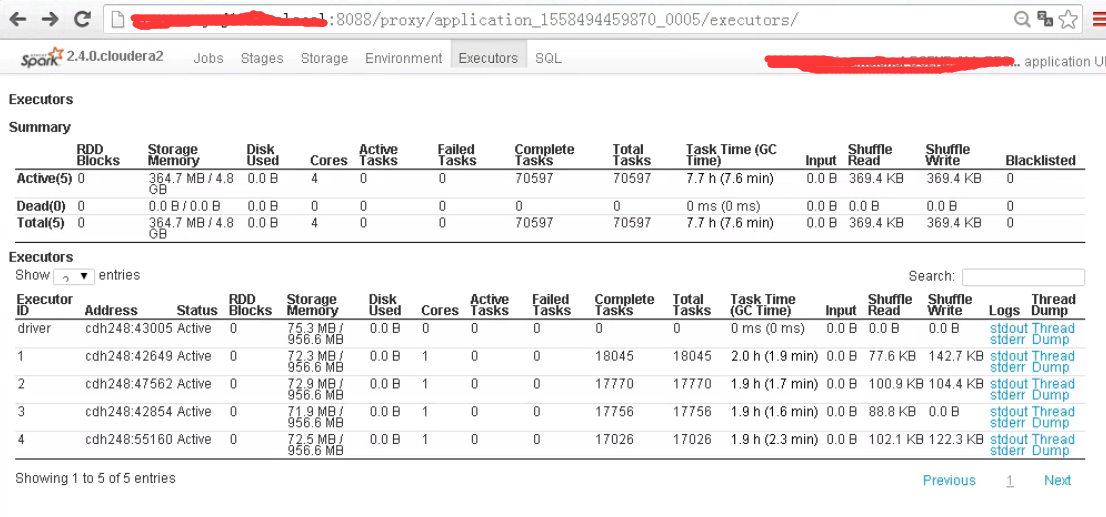
executors->ExecutorThreadDumpPage
http://ip:8088/proxy/application_1558494459870_0005/executors/threadDump/?executorId=[executorId或者driver]
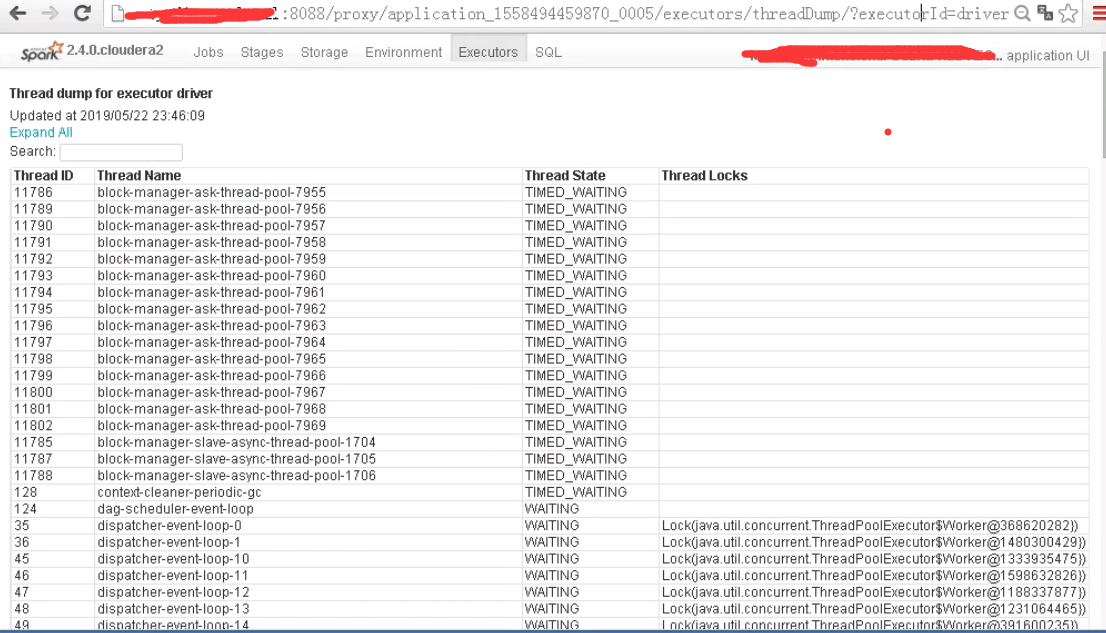
首先看下ExecutorsTab的代码
private[ui] class ExecutorsTab(parent: SparkUI) extends SparkUITab(parent, "executors") { init() private def init(): Unit = { val threadDumpEnabled = parent.sc.isDefined && parent.conf.getBoolean("spark.ui.threadDumpsEnabled", true) attachPage(new ExecutorsPage(this, threadDumpEnabled)) if (threadDumpEnabled) { attachPage(new ExecutorThreadDumpPage(this, parent.sc)) } } }
其中SparkUITab就是对WebUITab的简单封装,加上了Application名称和Spark版本属性。ExecutorsTab类包含了init()方法,在构造函数中调用了该init()方法,init()方法内部调用了SparkUITab类预定义好的attachPage(...)方法,将ExecutorsPage加入,当属性threadDumpEnabled为true时,也将ExecutorThreadDumpPage加入。
再来看下ExecutorsPage的代码
private[ui] class ExecutorsPage( parent: SparkUITab, threadDumpEnabled: Boolean) extends WebUIPage("") { def render(request: HttpServletRequest): Seq[Node] = { val content = <div> { <div id="active-executors" class="row-fluid"></div> ++ <script src={UIUtils.prependBaseUri(request, "/static/utils.js")}></script> ++ <script src={UIUtils.prependBaseUri(request, "/static/executorspage.js")}></script> ++ <script>setThreadDumpEnabled({threadDumpEnabled})</script> } </div> UIUtils.headerSparkPage(request, "Executors", content, parent, useDataTables = true) } }
render()方法用来渲染页面内容,其流程如下:
1)将content内容封装好;
2)调用UIUtils.headerSparkPage()方法,将content内容响应给浏览器;
3)浏览器加载过程中会调用executorspage.js,该JS内部会通过Rest服务器根据当前applicationId,去获取allexecutos等信息,并将allexecutos信息按照模板executorspage-template.html渲染到executors页面上。
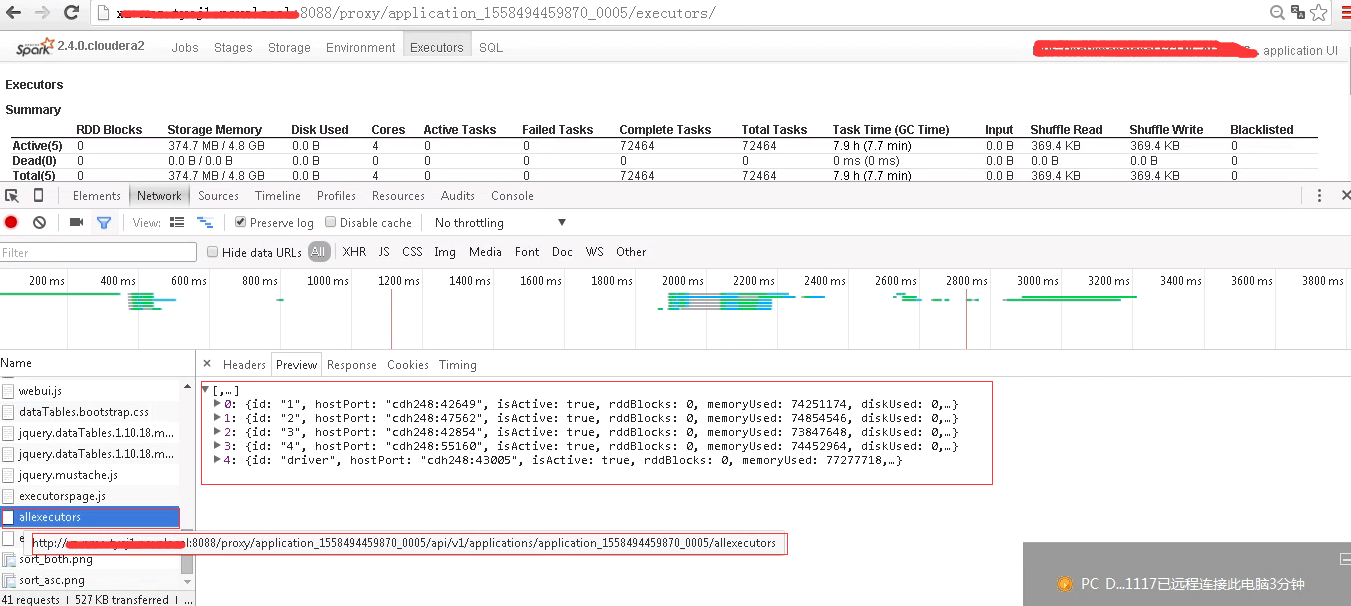
spark rest 服务实现代码路径:https://github.com/apache/spark/blob/branch-2.4/core/src/main/scala/org/apache/spark/status/api/v1/
返回allexecutors信息的方法:
@GET @Path("allexecutors") def allExecutorList(): Seq[ExecutorSummary] = withUI(_.store.executorList(false))
这里的store正式SparkUI的store。从该方法可以看出来:实际上,spark rest服务提供的数据是存储在SparkContext的AppStatusStore对象store上。
最后看下ExecutorThreadDumpPage的代码
private[ui] class ExecutorThreadDumpPage( parent: SparkUITab, sc: Option[SparkContext]) extends WebUIPage("threadDump") { // stripXSS is called first to remove suspicious characters used in XSS attacks def render(request: HttpServletRequest): Seq[Node] = { val executorId = Option(UIUtils.stripXSS(request.getParameter("executorId"))).map { executorId => UIUtils.decodeURLParameter(executorId) }.getOrElse { throw new IllegalArgumentException(s"Missing executorId parameter") } val time = System.currentTimeMillis() val maybeThreadDump = sc.get.getExecutorThreadDump(executorId) val content = maybeThreadDump.map { threadDump => val dumpRows = threadDump.map { thread => val threadId = thread.threadId val blockedBy = thread.blockedByThreadId match { case Some(_) => <div> Blocked by <a href={s"#${thread.blockedByThreadId}_td_id"}> Thread {thread.blockedByThreadId} {thread.blockedByLock}</a> </div> case None => Text("") } val heldLocks = thread.holdingLocks.mkString(", ") <tr id={s"thread_${threadId}_tr"} class="accordion-heading" onclick={s"toggleThreadStackTrace($threadId, false)"} onmouseover={s"onMouseOverAndOut($threadId)"} onmouseout={s"onMouseOverAndOut($threadId)"}> <td id={s"${threadId}_td_id"}>{threadId}</td> <td id={s"${threadId}_td_name"}>{thread.threadName}</td> <td id={s"${threadId}_td_state"}>{thread.threadState}</td> <td id={s"${threadId}_td_locking"}>{blockedBy}{heldLocks}</td> <td id={s"${threadId}_td_stacktrace"} class="hidden">{thread.stackTrace.html}</td> </tr> } <div class="row-fluid"> <p>Updated at {UIUtils.formatDate(time)}</p> { // scalastyle:off <p><a class="expandbutton" onClick="expandAllThreadStackTrace(true)"> Expand All </a></p> <p><a class="expandbutton hidden" onClick="collapseAllThreadStackTrace(true)"> Collapse All </a></p> <div class="form-inline"> <div class="bs-example" data-example-id="simple-form-inline"> <div class="form-group"> <div class="input-group"> Search: <input type="text" class="form-control" id="search" oninput="onSearchStringChange()"></input> </div> </div> </div> </div> <p></p> // scalastyle:on } <table class={UIUtils.TABLE_CLASS_STRIPED + " accordion-group" + " sortable"}> <thead> <th onClick="collapseAllThreadStackTrace(false)">Thread ID</th> <th onClick="collapseAllThreadStackTrace(false)">Thread Name</th> <th onClick="collapseAllThreadStackTrace(false)">Thread State</th> <th onClick="collapseAllThreadStackTrace(false)">Thread Locks</th> </thead> <tbody>{dumpRows}</tbody> </table> </div> }.getOrElse(Text("Error fetching thread dump")) UIUtils.headerSparkPage(request, s"Thread dump for executor $executorId", content, parent) } }
该页面主要展示当前executor中thread运行情况。
参考:
《Apache Spark源码走读之21 -- WEB UI和Metrics初始化及数据更新过程分析》
《Spark Structrued Streaming源码分析--(四)ProgressReporter每个流处理进度计算、StreamQueryManager管理运行的流》
《Spark Core源码精读计划#13:度量系统MetricsSystem的建立》
《Spark Core源码精读计划#14:Spark Web UI界面的实现》
基础才是编程人员应该深入研究的问题,比如:
1)List/Set/Map内部组成原理|区别
2)mysql索引存储结构&如何调优/b-tree特点、计算复杂度及影响复杂度的因素。。。
3)JVM运行组成与原理及调优
4)Java类加载器运行原理
5)Java中GC过程原理|使用的回收算法原理
6)Redis中hash一致性实现及与hash其他区别
7)Java多线程、线程池开发、管理Lock与Synchroined区别
8)Spring IOC/AOP 原理;加载过程的。。。
【+加关注】。


